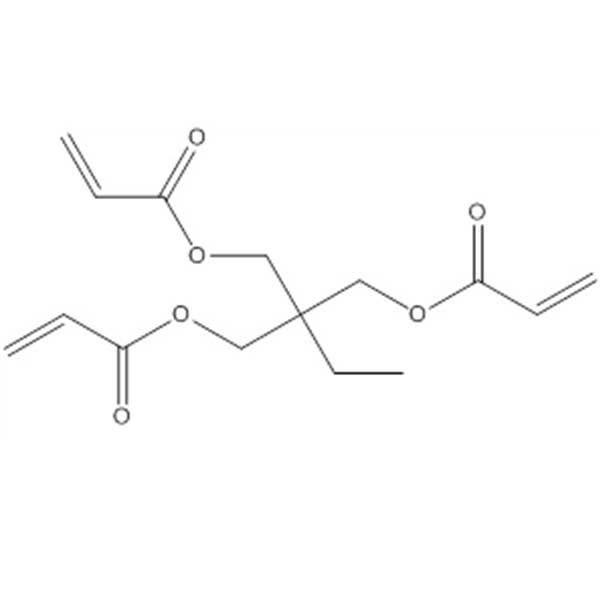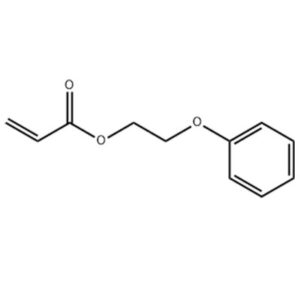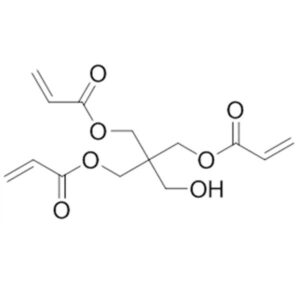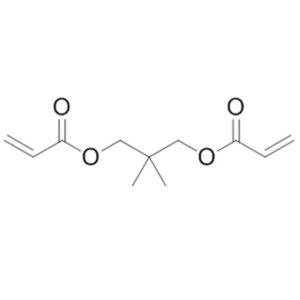Description
TMPTA Monomer / Trimethylolpropane triacrylate CAS 15625-89-5
Item |
Specifications |
Results |
Appearance |
Light yellow transparent liquid |
Conforms |
Solid content (wt%) |
≥98.00% |
99.65% |
Acid value (mgkoh/g) |
≤1.00 |
0.40 |
Viscosity (cps25 degree) |
80~120 |
120 |
Color (Pt-Co) |
≤60 |
30 |
Conclusion |
The results conforms with Enterprise standards |
|
What is TMPTA Monomer?
1. TMPTA belongs to polyol acrylate, which is an important multifunctional monomer with high activity. The trimethyl propylene dilute acid ester has high molecular double bond content and fast curing speed. It is an excellent crosslinking agent and curing agent. Due to the high boiling point of Trimethylolpropane triacrylate, there is no solvent volatilization during the curing process. It is not only environmentally friendly, but also highly energy-saving. Therefore, it is widely used in many fields such as coatings, adhesives, inks, electronics, and rubber. The synthesis of trimethyl propylene triacrylate is of great significance.
2. TMPTA is a newly developed variety in the acrylic series products, and is an important trifunctional acrylate functional monomer. Because TMPTA has the characteristics of high double bond content, fast curing speed, low viscosity, high boiling point, low volatility, etc., it has become the most widely used and the largest amount of multifunctional acrylic reactive crosslinking diluent in the field of radiation curing. At present, TMPTA is mainly synthesized by the direct esterification of trimethylpropane (TM) P and acrylic acid (AA) or the transesterification of TMP with methyl acrylate (MA). Most of the catalysts used in this process are sulfuric acid or p-toluenesulfonic acid. [‘Several due to equipment corrosion and complex processes such as neutralization and water washing during post-treatment, the product cost is relatively high. The author uses trimethylpropane and acrylic acid as raw materials, sulfuric acid as a catalyst, cyclohexane and toluene as a water-carrying agent, and a mixed system of hydroquinone and phenoin as a polymerization inhibitor to synthesize TMPTA, which has achieved good results.
3. TMPTA Monomer is a versatile monomer with a wide range of industrial applications as a crosslinker, reactive diluent and chemical intermediate.TMPTA Monomer is used in the production of UV-curable inks, electron beam irradiation-curable coatings, thermal papers, plastic hardeners, optical fibers, UV-curable acrylic varnishes for the furniture industry, polymers and resins; TMPTA Monomer is used as a component of photopolymers and flexographic printing plates and photoresists; and as a component of acrylic glues, adhesives and anaerobic sealants.
This product can replace 2,2-bis(acryloyloxymethyl)butyl acrylate; 2; ,2-bis(acryloyloxymethyl)butyl acrylate; trimethylolpropane triacrylate; 2-ethyl-2-[[(1-oxoallyl)oxy]methyl]-1,3-propanediyl diacrylate; Acrylic acid, triester with 2-ethyl-2-(hydroxymethyl)-1,3-propanediol; MFM; NK Ester A TMPT; Ogumont T 200; Saret 351; Sartomer SR 351; Setalux UV 2241; SR 351; Trimethylolpropane triacrylate.
Product features
high solid content, low viscosity, low solvent residue, good color, almost no low polymer, low moisture, low acid value, low polymerization inhibitor content
Trimethylolpropane triacrylate Usage
1. TMPTA Monomer (TRIMETHYLOLPROPANE TRIACRYLATE) is a widely used reactive diluent in ultraviolet light (UV) and electron beam (EB) curable coatings and inks.
2. TMPTA Monomer can be used as a vulcanization activator for special rubber. Special rubbers such as ethylene propylene rafter rubber and EPDM rubber, chloro rubber, silicone rubber, polyurethane, ethylene/vinyl acetate copolymer (EVA), chlorinated polyethylene elastomer (CPE), etc. are difficult to vulcanize, and organic Peroxide (such as DCP, BPO) is vulcanized. If a single organic peroxide is used for vulcanization, the vulcanization time is too long and the vulcanization is insufficient, and it is difficult to ensure good mechanical and physical properties. Therefore, TMPTMA must be added as a vulcanizing aid to achieve good results.
3. For example, organic fluorine rubber, etc., when using DCP for vulcanization, if the additive 1~4% TMPTMA is used as a vulcanizing agent, it can not only greatly shorten the vulcanization time, increase the degree of vulcanization, reduce the amount of DCP, but also significantly improve the mechanical Strength, wear resistance, solvent resistance and corrosion resistance etc.
4. In the vulcanization process of fluorine-containing rubber, the double bond in the TMPTMA molecule not only participates in the vulcanization cross-linking reaction, but also acts as a hydrogen halide (HF, HCL, etc.) acceptor to absorb the hydrogen halide released during processing , Which not only improves the quality of products, but also greatly reduces the corrosivity of vulcanized rubber. The rubber compound containing TMPTMA has a plasticizing effect during mixing and a hardening effect after vulcanization.
Trimethylolpropane triacrylate Packaging
25kg; 200kgs/drum.
Temperature: 0℃-30℃, storage period is 12 months.
Measured Atlas

Contact Us Now!
If you need Price and Sample Testing, please fill in your contact information in the form below, we will usually contact you within 24 hours. You could also email me info@longchangchemical.com during working hours ( 8:30 am to 6:00 pm UTC+8 Mon.~Sat. ) or use the website live chat to get prompt reply.
| Polythiol/Polymercaptan | ||
| DMES Monomer | Bis(2-mercaptoethyl) sulfide | 3570-55-6 |
| DMPT Monomer | THIOCURE DMPT | 131538-00-6 |
| PETMP Monomer | 7575-23-7 | |
| PM839 Monomer | Polyoxy(methyl-1,2-ethanediyl) | 72244-98-5 |
| Monofunctional Monomer | ||
| HEMA Monomer | 2-hydroxyethyl methacrylate | 868-77-9 |
| HPMA Monomer | 2-Hydroxypropyl methacrylate | 27813-02-1 |
| THFA Monomer | Tetrahydrofurfuryl acrylate | 2399-48-6 |
| HDCPA Monomer | Hydrogenated dicyclopentenyl acrylate | 79637-74-4 |
| DCPMA Monomer | Dihydrodicyclopentadienyl methacrylate | 30798-39-1 |
| DCPA Monomer | Dihydrodicyclopentadienyl Acrylate | 12542-30-2 |
| DCPEMA Monomer | Dicyclopentenyloxyethyl Methacrylate | 68586-19-6 |
| DCPEOA Monomer | Dicyclopentenyloxyethyl Acrylate | 65983-31-5 |
| NP-4EA Monomer | (4) ethoxylated nonylphenol | 50974-47-5 |
| LA Monomer | Lauryl acrylate / Dodecyl acrylate | 2156-97-0 |
| THFMA Monomer | Tetrahydrofurfuryl methacrylate | 2455-24-5 |
| PHEA Monomer | 2-PHENOXYETHYL ACRYLATE | 48145-04-6 |
| LMA Monomer | Lauryl methacrylate | 142-90-5 |
| IDA Monomer | Isodecyl acrylate | 1330-61-6 |
| IBOMA Monomer | Isobornyl methacrylate | 7534-94-3 |
| IBOA Monomer | Isobornyl acrylate | 5888-33-5 |
| EOEOEA Monomer | 2-(2-Ethoxyethoxy)ethyl acrylate | 7328-17-8 |
| Multifunctional monomer | ||
| DPHA Monomer | 29570-58-9 | |
| DI-TMPTA Monomer | DI(TRIMETHYLOLPROPANE) TETRAACRYLATE | 94108-97-1 |
| Acrylamide monomer | ||
| ACMO Monomer | 4-acryloylmorpholine | 5117-12-4 |
| Di-functional Monomer | ||
| PEGDMA Monomer | Poly(ethylene glycol) dimethacrylate | 25852-47-5 |
| TPGDA Monomer | Tripropylene glycol diacrylate | 42978-66-5 |
| TEGDMA Monomer | Triethylene glycol dimethacrylate | 109-16-0 |
| PO2-NPGDA Monomer | Propoxylate neopentylene glycol diacrylate | 84170-74-1 |
| PEGDA Monomer | Polyethylene Glycol Diacrylate | 26570-48-9 |
| PDDA Monomer | Phthalate diethylene glycol diacrylate | |
| NPGDA Monomer | Neopentyl glycol diacrylate | 2223-82-7 |
| HDDA Monomer | Hexamethylene Diacrylate | 13048-33-4 |
| EO4-BPADA Monomer | ETHOXYLATED (4) BISPHENOL A DIACRYLATE | 64401-02-1 |
| EO10-BPADA Monomer | ETHOXYLATED (10) BISPHENOL A DIACRYLATE | 64401-02-1 |
| EGDMA Monomer | Ethylene glycol dimethacrylate | 97-90-5 |
| DPGDA Monomer | Dipropylene Glycol Dienoate | 57472-68-1 |
| Bis-GMA Monomer | Bisphenol A Glycidyl Methacrylate | 1565-94-2 |
| Trifunctional Monomer | ||
| TMPTMA Monomer | Trimethylolpropane trimethacrylate | 3290-92-4 |
| TMPTA Monomer | Trimethylolpropane triacrylate | 15625-89-5 |
| PETA Monomer | 3524-68-3 | |
| GPTA ( G3POTA ) Monomer | GLYCERYL PROPOXY TRIACRYLATE | 52408-84-1 |
| EO3-TMPTA Monomer | Ethoxylated trimethylolpropane triacrylate | 28961-43-5 |
| Photoresist Monomer | ||
| IPAMA Monomer | 2-isopropyl-2-adamantyl methacrylate | 297156-50-4 |
| ECPMA Monomer | 1-Ethylcyclopentyl Methacrylate | 266308-58-1 |
| ADAMA Monomer | 1-Adamantyl Methacrylate | 16887-36-8 |
| Methacrylates monomer | ||
| TBAEMA Monomer | 2-(Tert-butylamino)ethyl methacrylate | 3775-90-4 |
| NBMA Monomer | n-Butyl methacrylate | 97-88-1 |
| MEMA Monomer | 2-Methoxyethyl Methacrylate | 6976-93-8 |
| i-BMA Monomer | Isobutyl methacrylate | 97-86-9 |
| EHMA Monomer | 2-Ethylhexyl methacrylate | 688-84-6 |
| EGDMP Monomer | Ethylene glycol Bis(3-mercaptopropionate) | 22504-50-3 |
| EEMA Monomer | 2-ethoxyethyl 2-methylprop-2-enoate | 2370-63-0 |
| DMAEMA Monomer | N,M-Dimethylaminoethyl methacrylate | 2867-47-2 |
| DEAM Monomer | Diethylaminoethyl methacrylate | 105-16-8 |
| CHMA Monomer | Cyclohexyl methacrylate | 101-43-9 |
| BZMA Monomer | Benzyl methacrylate | 2495-37-6 |
| BDDMP Monomer | 1,4-Butanediol Di(3-mercaptopropionate) | 92140-97-1 |
| BDDMA Monomer | 1,4-Butanedioldimethacrylate | 2082-81-7 |
| AMA Monomer | Allyl methacrylate | 96-05-9 |
| AAEM Monomer | Acetylacetoxyethyl methacrylate | 21282-97-3 |
| Acrylates Monomer | ||
| IBA Monomer | Isobutyl acrylate | 106-63-8 |
| EMA Monomer | Ethyl methacrylate | 97-63-2 |
| DMAEA Monomer | Dimethylaminoethyl acrylate | 2439-35-2 |
| DEAEA Monomer | 2-(diethylamino)ethyl prop-2-enoate | 2426-54-2 |
| CHA Monomer | cyclohexyl prop-2-enoate | 3066-71-5 |
| BZA Monomer | benzyl prop-2-enoate | 2495-35-4 |







Vanessa madriaga –
Thanks for the very successful cooperation, especially in the case of recent product supply problems, longchang chemcial can still deliver within the specified time.
info@longchangchemical.com –
Thanks for your comment, looking forward to the next cooperation.